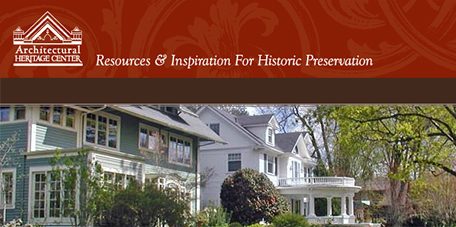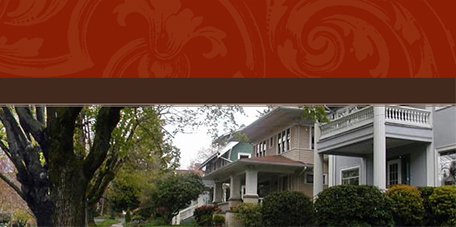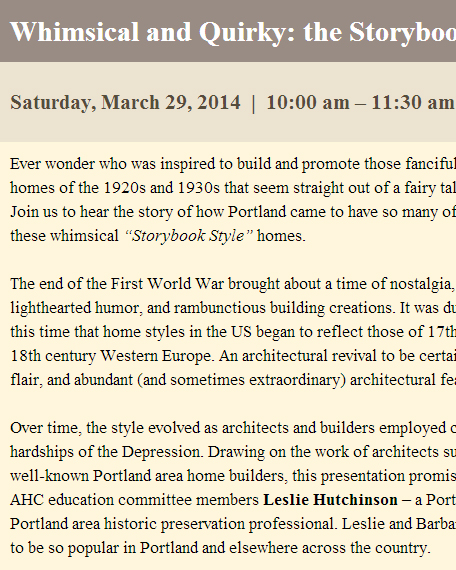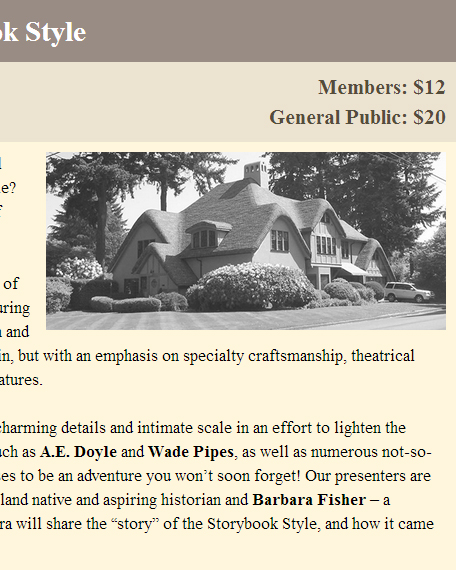| Upcoming Winter Education Programs Click on program titles for more information Portland 101: Crooked Grids, Tiny Blocks, and the Building of the City |
| Portland 101: Crooked Grids, Tiny Blocks, and the Building of the City | |
| Saturday, January 25, 2014 | 10:00 am – 11:30 am | Members: $12 General Public: $20 |
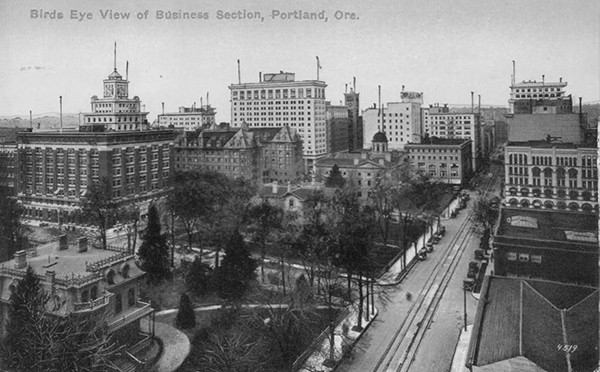 How did Portland get this way, with its little square blocks and weird intersections, the funny pronunciations and the bridge ramps to nowhere? Why is it even located where it is? There’s a reason for everything (we didn’t say a good reason…)! How did Portland get this way, with its little square blocks and weird intersections, the funny pronunciations and the bridge ramps to nowhere? Why is it even located where it is? There’s a reason for everything (we didn’t say a good reason…)! Stone carver’s mistakes, upside-down pineapples, and mythical tunnels are just part of the things true Portland residents should know about – we’ll look at the grid, the naming and re-naming of our streets, and the eras of commercial architecture that have marked our compact and vibrant downtown, as well as the near blitzkrieg effect of the Great Demolition which left us with parking lots where the temples of finance and industry once stood. Long time AHC Education Committee member Robert Jordan will guide us through 150 years of Portland’s development – a great overview for those just getting interested in Portland’s architectural heritage as well as for anyone who ever wondered, “Why did they do THAT?” |
|
| Preservation in Progress: A Tour of Historic Washington High School | |
| Saturday, February 1, 2014 | 10:00 am – 12:00 pm | All Tickets: $15 |
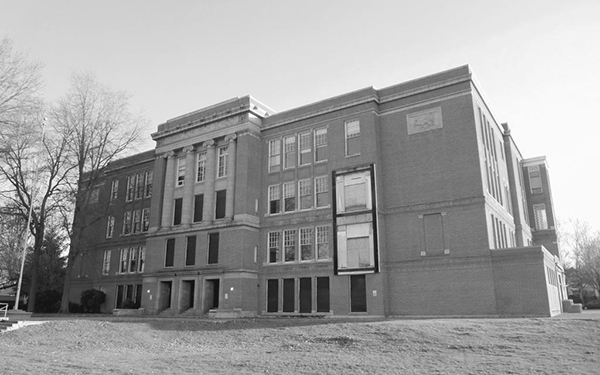 Take a tour of historic Washington High School and see work in progress to convert this Southeast Portland landmark into office and retail spaces, along with an event space that will utilize the wonderful auditorium. Take a tour of historic Washington High School and see work in progress to convert this Southeast Portland landmark into office and retail spaces, along with an event space that will utilize the wonderful auditorium. Built in 1923 after a fire destroyed the 1906 school building, Washington High School stands today as a testament to views on public education in the 1920s. It is also a superb example of the work of the architectural firm Houghtaling and Dougan and the most intact surviving school in the Classical Revival style. The school closed in 1981, and for more than 30 years, the building has been under-utilized, housing other services, hosting arts events and even refugees from Hurricane Katrina. Now, however, the building is being brought back to life by Venerable Development, LLC. Join us for this hard-hat tour and you’ll learn some of the history of this Buckman Neighborhood landmark, how the building has now been saved from the wrecking ball, the restoration work being done, and plans for the historic school that promise an exciting future! Meet at the entrance to Washington High School at 531 SE 14th Avenue, just off Stark Street. Sponsored by: Venerable Development, LLC |
|
| In the Shadow of a Concrete Forest: The Mt. Hood Freeway Story | |
| Tuesday, February 4, 2014 | 7:00 pm – 8:30 pm Saturday, March 22, 2014 | 10:00 am – 11:30 am |
Members: $12 General Public: $20 |
|
On February 4, 1974, a judges ruling put a halt to further development of the proposed Mt. Hood Freeway, a roadway that for nearly 20 years most people had assumed would be constructed. Oven the next few years the freeway died a slow controversial death, but although it never came to pass, the Mt. Hood Freeway still left an indelible mark on Southeast Portland. |
|
| A House of Stone for Dr. Mackenzie: The Legacy of McCaw, Martin, and White |
|
| Saturday, February 8, 2014 | 10:00 am – 11:30 am | Members: $12 General Public: $20 |
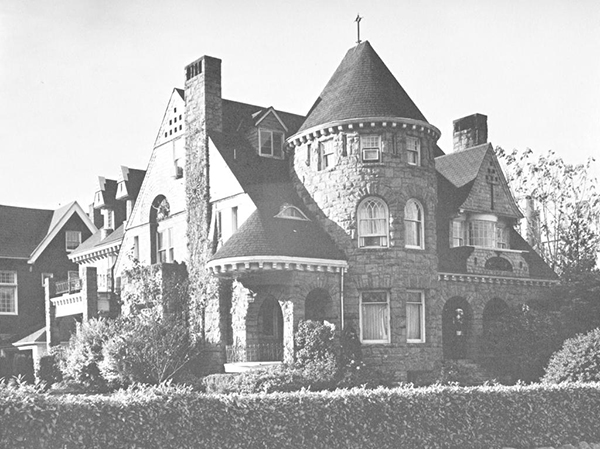 Long acclaimed as a masterwork of architects Whidden and Lewis, the Dr. Kenneth A. J. and Cora Mackenzie residence was established in 2012 as the work of another firm, McCaw and Martin, and the National Register of Historic Places nomination was subsequently revised. Now the William Temple House, this Portland landmark has delighted observers with its intriguing design and exceptional craftsmanship ever since its completion in 1892. Long acclaimed as a masterwork of architects Whidden and Lewis, the Dr. Kenneth A. J. and Cora Mackenzie residence was established in 2012 as the work of another firm, McCaw and Martin, and the National Register of Historic Places nomination was subsequently revised. Now the William Temple House, this Portland landmark has delighted observers with its intriguing design and exceptional craftsmanship ever since its completion in 1892. Masters of the Richardsonian Romanesque, William F. McCaw and Richard H. Martin, Jr. are best known as architects of Portland’s Dekum Building, the Armory (now the Gerding Theater), the First Presbyterian Church, and the University of Portland’s West Hall. They were also briefly associated with another notable Portland architect – F. Manson White. This presentation, an update of an AHC lecture given in 2012, demonstrates how the increasing availability of digitized resources is enabling a richer understanding of Portland’s architectural heritage. Our presenter, Ed Teague, is the head of the Architecture and Allied Arts Library at the University of Oregon. |
|
| Shake, Rattle & Roll – Getting your house ready for the “Big One!” | |
| Saturday, March 1, 2014 | 10:00 am – 12:00 Noon | Members: $8 General Public: $12 |
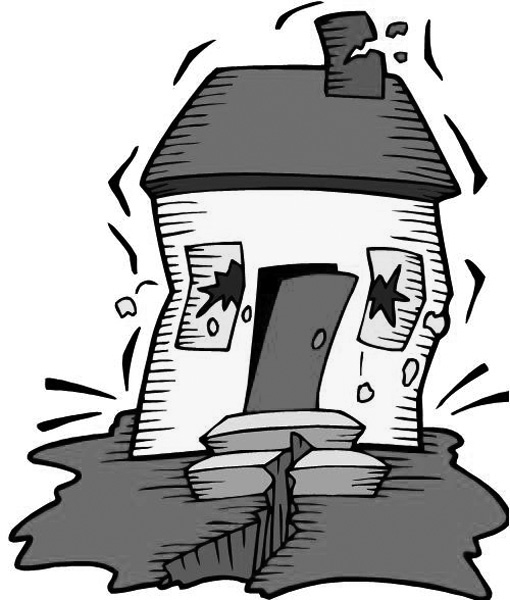 The Pacific Northwest and the Portland area are no strangers to the threat of impending earthquakes and this is made all-too-clear when an earthquake devastates some part of the world – whether near or far. The potential for the “Big One” has generated considerable press and anxiety in recent years. So – what are Portland-area homeowners to do, to increase the chances that your house will survive?” This encore program “Shake, Rattle & Roll” is just the thing to help you answer that question. The Pacific Northwest and the Portland area are no strangers to the threat of impending earthquakes and this is made all-too-clear when an earthquake devastates some part of the world – whether near or far. The potential for the “Big One” has generated considerable press and anxiety in recent years. So – what are Portland-area homeowners to do, to increase the chances that your house will survive?” This encore program “Shake, Rattle & Roll” is just the thing to help you answer that question. Scott Burns, Professor of Geology at PSU, is the guy who is on every local newscast following an earthquake. Scott will explain the complex seismic fault lines that run through the Portland area and surroundings, and how buildings behave in an earthquake. Steve Gemmell, owner of Earthquake Tech, will describe the step-by-step procedure for bolting your house and other improvements that can help your house ride the big one. Mark Strauss, independent agent with Leonard Adams Insurance, will cover earthquake options for homeowners. DON’T MISS this opportunity to learn how to prepare for an earthquake emergency and make certain that your house is as safe as it can be for you and your family. |
|
| Richardson Comes West: Romanesque Architecture in Portland | |
| Saturday, March 8, 2014 | 10:00 am – 11:30 am | Members: $12 General Public: $20 |
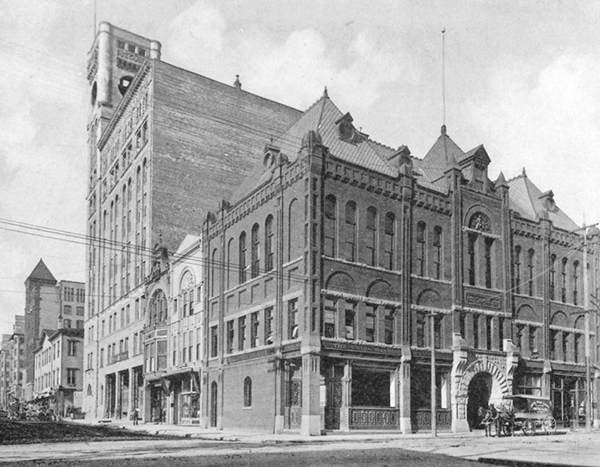 Henry Hobson Richardson (1838 – 1886), the interpreter of the Romanesque style, practiced in Boston but influenced architects throughout the nation. Here in Portland, numerous buildings were constructed in the 1880s and 1890s that reflected the Richardson aesthetic. Henry Hobson Richardson (1838 – 1886), the interpreter of the Romanesque style, practiced in Boston but influenced architects throughout the nation. Here in Portland, numerous buildings were constructed in the 1880s and 1890s that reflected the Richardson aesthetic. The Richardsonian Romanesque style, with its heavy rustic stonework, Roman arches, use of red brick, and unglazed terra cotta, was popular for only a short time in Portland, but the buildings constructed in this style have had a lasting impact on the city. Perhaps the most notable of these buildings is the Dekum Building, built in 1892 and designed by the firm of McCaw and Martin. Others include the Auditorium Building and the New Market Annex – all of these buildings denoted a dramatic change in the city’s preferred architectural style, while also demarcating how the heart of downtown was, by the late 1880s, quickly moving away from the waterfront. To tell the fascinating story of how a Pacific Northwest city became enraptured in an architectural style, even in the wake of the passing of its progenitor, we present Leland Roth, the Marion D. Ross Distinguished Professor of Architectural History, Emeritus, at the University of Oregon. Roth is the author of several books, including American Architecture: A History (2001) and Shingle Styles: Innovation and Tradition in American Architecture, 1874 to 1984 (1999). |
|
| Moderate Modernist: The Life and Work of Architect Ellis F. Lawrence | |
| Saturday, March 15, 2014 | 10:00 am – 11:30 am | Members: $12 General Public: $20 |
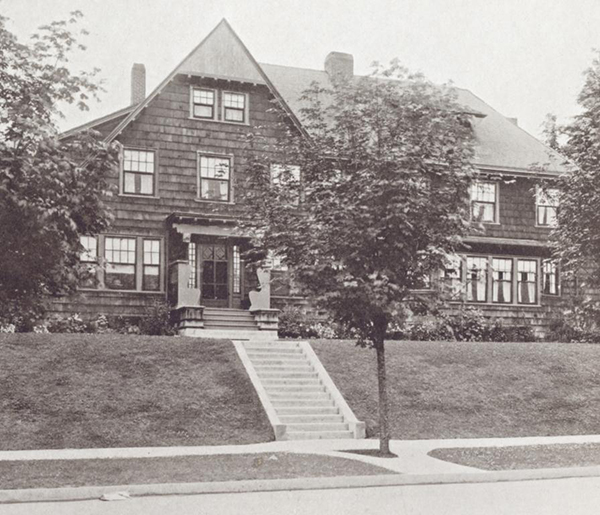 Ellis Fuller Lawrence (1879-1946) was born in Massachusetts and received his architectural training at MIT in the classical Beaux Arts tradition. He came to Portland in 1906 and designed over 500 buildings in his nearly forty-year career. Equally important to his private practice was his advocacy for the profession of architecture and his role in advancing architectural education. Ellis Fuller Lawrence (1879-1946) was born in Massachusetts and received his architectural training at MIT in the classical Beaux Arts tradition. He came to Portland in 1906 and designed over 500 buildings in his nearly forty-year career. Equally important to his private practice was his advocacy for the profession of architecture and his role in advancing architectural education. The Ellis Lawrence House (1906) in Irvington is considered one of the first Arts and Crafts residences in Portland. However, Lawrence’s architectural palette was quite eclectic, ranging from the formal and historical to the picturesque and modern. Many of his designs display a surprising juxtaposition of the traditional and modern, especially his institutional buildings. Two of his best known buildings in Portland are the Albina Branch Library (1912) and the Riverview Cemetery Caretaker's House (1914). But perhaps Lawrence’s most significant contribution to regional architecture was as founder and first dean of the School of Architecture and Allied Arts at the University of Oregon. During his lengthy tenure at the U of O, Lawrence designed more than two dozen campus buildings while also helping to mentor a new generation of architects in the less formalized approach of the Modern movement. We hope you’ll join us as architectural historian, AHC Education Committee member, and walking tour docent Eric Wheeler takes us on a whirlwind exploration of the career of one of Oregon’s first modernist architects. |
|
